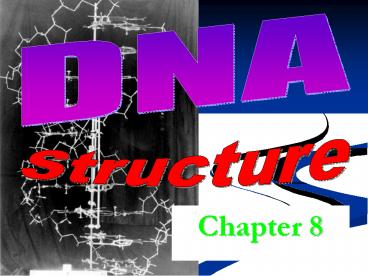DNA, Transcription, Translation - PowerPoint PPT Presentation
Title:
DNA, Transcription, Translation
Description:
Title: DNA, Transcription, Translation Author: W.J.U.S.D. Last modified by: Nicole Hooper Created Date: 1/21/2005 9:55:48 PM Document presentation format – PowerPoint PPT presentation
Number of Views:97
Avg rating:3.0/5.0
Title: DNA, Transcription, Translation
1
DNA
Structure
- Chapter 8
2
- http//youtu.be/zwibgNGe4aY
- Be ready to write down 3 things you remember from
the video!
3
DNA Stands for
- DNA Deoxyribonucleic acid
- Very large biomolecule made up of nucleotides
- Called the blueprints of life because it
contains genetic information for the construction
of proteins.
4
- Floats freely in the cytoplasm of prokaryotes
- Protected in the nucleus of eukaryotes
5
- Nucleotide DNA subunit (monomer) made up of 3
parts - Deoxyribose sugar
- Phosphate group
- Nitrogenous base
6
DNA Structure
- Made of 2 nucleotide chains that wrap around each
other to form a double helix (looks like a spiral
staircase) - The sides Alternating Sugar, phosphate, sugar,
phosphate - The middle Nitrogen bases paired together.
7
Scientists Involved in Discovery of DNA
- James Watson Francis Crick
- developed double helix model of DNA
- other scientists working on finding the
structure - Rosalind Franklin
- Maurice Wilkins
- Linus Pauling
Wilkins
Pauling
Franklin
8
1953 article in Nature
Watson and Crick
Watson
Crick
9
Nitrogenous Bases
- There are 2 groups of nitrogenous bases purines
and pyrimidines - Purines Made up of two rings of carbon and
nitrogen - Adenine (A), Guanine (G)
10
- Pyrimidines Bases that have one ring of carbon
and nitrogen - Thymine (T), Cytosine (C)
11
Identifying the structure
Purine purine too wide
Pyrimidine pyrimidine too narrow
Purine pyrimidine width consistent with X-ray
data
12
Conclusion Purine (A, G) pair with Pyrimidine
(C, T)
Adenine (A)
Thymine (T)
Cytosine (C)
Guanine (G)
13
Chargaffs Base Pairing Rules
- DNA composition Chargaffs rules
- varies from species to species
- all 4 bases not in equal quantity
- bases present in characteristic ratio
- humans
- A 30.9
- T 29.4
- G 19.9
- C 19.8
1947
Thats interesting!What do you notice?
14
Chargaffs Base Pairing Rules
- A pairs with T
- Always Together
- G pairs with C
- Get Closer
15
Summary
- Summarize what we just talked about by
- Come up with 3 alternate titles for our notes
- OR Drawing a picture to remember base pairing
- OR Writing about how DNA structure is like a
staircase































